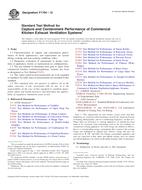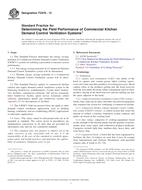Potřebujeme váš souhlas k využití jednotlivých dat, aby se vám mimo jiné mohly ukazovat informace týkající se vašich zájmů. Souhlas udělíte kliknutím na tlačítko „OK“.
ASTM E2320-04(2012)
Standard Classification for Serviceability of an Office Facility for Thermal Environment and Indoor Air Conditions
Automaticky přeložený název:
Standardní klasifikace pro dopravní obslužnost o nástroje Office pro tepelnou životního prostředí a ovzduší v interiéru podmínky
NORMA vydána dne 1.4.2012
Informace o normě:
Označení normy: ASTM E2320-04(2012)
Poznámka: NEPLATNÁ
Datum vydání normy: 1.4.2012
Kód zboží: NS-45026
Počet stran: 14
Přibližná hmotnost: 42 g (0.09 liber)
Země: Americká technická norma
Kategorie: Technické normy ASTM
Kategorie - podobné normy:
Anotace textu normy ASTM E2320-04(2012) :
Keywords:
air quality, building, facility, facility occupants, function, humidity, indoor air, office performance, rating, rating scale, requirements, serviceability, temperature, thermal environment, ventilation, ICS Number Code 91.140.30 (Ventilation and air-conditioning systems)
Doplňující informace
| Significance and Use | ||||||||||
|
Each Occupant Requirement Scale (see Figs. 1-5) in this classification provides a means to set the required level of serviceability of a building or facility for one topic of serviceability and to compare that level against any level of any other occupant, or of any building or facility. Each Facility Rating Scale (see Figs. 1-5) in this classification provides a means to estimate the level of serviceability of a building or facility for one topic of serviceability and to compare that level against any level of requirement of any occupant, or of any other building or facility. This classification can be used for comparing how well different buildings or facilities meet a particular requirement for serviceability. It is applicable despite differences such as location, structure, mechanical systems, age, and building shape. This classification can be used to estimate the amount of variance of serviceability from target or from requirement, for a single office facility, or within a group of office facilities. This classification can be used to estimate the following: Serviceability of an existing facility for uses other than its present use. Serviceability (potential) of a facility that has been planned but not yet built. Serviceability (potential) of a facility for which remodeling has been planned. Use of this classification does not result in building evaluation or diagnosis. Building evaluation or diagnosis generally requires a special expertise in building engineering or technology, and the use of instruments, tools, or measurements. This classification applies only to facilities that are building constructions, or part thereof. (While classification may be useful in rating the serviceability of facilities that are not building constructions, such facilities are outside the scope of this classification. See discussion under definition 3.1.1.) This classification is not intended for, and is not suitable for, use for regulatory purposes nor for fire hazard assessment nor for fire risk assessment. |
||||||||||
| 1. Scope | ||||||||||
|
1.1 This classification contains pairs of scales for classifying an aspect of the serviceability of an office facility, that is, the capability of an office facility to meet certain possible requirements for suitable thermal environment and indoor air conditions. 1.2 Within this aspect of serviceability, each pair of scales, shown in Figs. 1-5 , is for classifying one topic of serviceability. Each paragraph in an Occupant Requirement Scale (see Figs. 1-5) summarizes one level of requirement for serviceability on that topic, which occupants might require. The matching paragraph in the Facility Rating Scale (see Figs. 1-5) is a translation of the requirement into a description of certain features of a facility which, taken in combination, indicate that the facility is likely to meet that level of required serviceability. 1.3 The paragraphs in the Facility Rating Scale (see Figs. 1-5) are indicative and not comprehensive. They are for quick scanning to estimate approximately, quickly, and economically how well a facility is likely to meet the needs of one or another type of occupant group over time. The paragraphs are not for measuring, knowing, or evaluating how an office facility is performing. 1.4 This classification can be used to estimate the level of serviceability of an existing facility. It can also be used to estimate the serviceability of a facility that has been planned but not yet built, such as one for which schematic or preliminary drawings and outline specifications have been prepared. 1.5 This standard indicates what would cause a facility to be rated (classified) at a certain level of serviceability but does not state how to conduct a serviceability rating or how to assign a serviceability score. That information is found in Practice E1334. The scales in this classification are complimentary to and compatible with Practice E1334. Each requires the other. 1.6 This standard indicates what would cause a requirement to be classified as being at a specific level, but does not state how to ascertain a requirement, or how to assign a specific level. This information is found in Practice E1679. The scales in this classification are complimentary to and compatible with Practice E1679. Each requires the other. 1.7 This standard does not purport to address all of the safety concerns, if any, associated with its use. It is the responsibility of the user of this standard to establish appropriate safety and health practices and determine the applicability of regulatory requirements prior to use.
|
||||||||||
| 2. Referenced Documents | ||||||||||
|
Podobné normy:
Historická
15.1.2010
Historická
1.10.2013
Historická
1.8.2012
Historická
1.1.2012
Historická
1.10.2012
Historická
1.6.2013



 ASTM E779-10
ASTM E779-10 ASTM F1005-91(2013)..
ASTM F1005-91(2013).. ASTM F1704-12
ASTM F1704-12 ASTM F2934-12
ASTM F2934-12 ASTM F2975-12
ASTM F2975-12 ASTM F2976-13
ASTM F2976-13
 Cookies
Cookies
